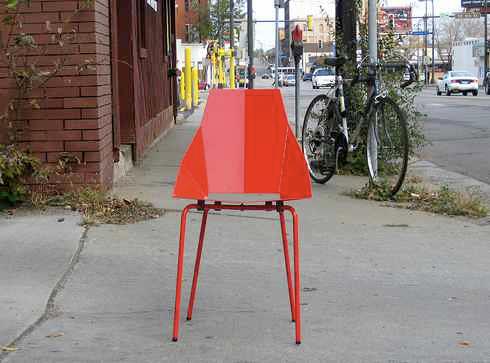


RAFFAELLO D’ ANDREA AND MAX DEAN
The Robotic Chair
The Robotic Chair is a generic-looking wooden chair with the capacity to fall apart and put itself back together. With shuddering force, the chair collapses to the floor. With persistence and determination, it proceeds to seek out its parts and upright itself. Powered by MICROMO coreless dc motors, The Robotic Chair is distinguished in the world of objects for its capacity to elicit empathy, compassion and hope.

Doug Aitken
The Garden
The Garden is a living artwork that embraces the dichotomy between the natural environment and a synthetic man-made experience. Aitken’s The Garden installation brings the viewer into the center of the artwork and asks them to physically immerse, participate and become the subject of the installation. Set inside a dark warehouse space the viewer walks inside, their eyes adjusting to become aware of thick lush jungle growing under artificial grow lights. Walking closer, the viewer enters inside the jungle and discovers a huge rectangular glass cube. Inside the glass room is a man-made environment replete with generic elements of modern life: tables and chairs, a cabinet, a sterile tableau set under bright raking lights.

Juri Hwang
Somatic Echo
“Somatic Echo” is an experimental sound art and research project that utilizes bone conducted sound as a method to investigate human audition and create an unusual and mesmerizing aesthetic of the body as a medium of sound. The installation uses a reclining chair and a sound mask to play an 8-channel sound composition through 8 transducers placed on the user’s head: 6 channels in the face and 2 in the back of the head. The transducers transmit sound through the bone structure of the skull directly to the listener’s inner ear, bypassing the outer ears, which normally are the gateway for auditory signals. The listeners experience the soundscape through both their auditory and tactile senses perceiving a sonic image shaped by the sound traveling through the head structure and through vibrations applied to the skin. This set up lets us experience sound through our body and our body through sound.

Van Grimde Corps Secrets
Eve 2050
Nous sommes en 2050, dans un monde ou être humain ne signifie plus la même chose. Les avancées technologiques et biomédicales des 30 dernières années ont bouleversé le statut du corps et redéfini les identités. Certains humains ont embrassé les progrès technologiques, jusqu’à augmenter leurs corps avec des dispositifs artificiels. D’autres ont préféré s’hybrider avec d’autres espèces, faisant du biologique et du vivant leur technologie à eux. D’autres encore chérissent et honorent le corps originel, refusant toute modification corporelle ou n’ayant pas les moyens de s’augmenter. La web série Eve 2050 nous emmène au cœur de ce monde étonnant à travers 5 épisodes qui suivent le parcours d’Eve. Personnage symbolique, de toutes origines culturelles, à la fois enfant et adulte, homme, femme, transgenre, être de chair, virtuel ou artificiel. Eve 2050 propose un voyage inédit vers les corps et les êtres de demain.

JOSIAH MCELHENY
Interactions du corps abstrait
Avec “Interactions of the Abstract Body”, McElheny a poussé ces idées plus loin, créant un ensemble de travaux vaste et varié qui examine comment la mode et le modernisme se sont entrecroisés et influencés, en particulier à travers le langage commun du corps. Fondamentalement, McElheny a animé cette dynamique avec la présence constante d’un interprète. En combinant une performance continue en chair et en os avec une sculpture statique dans le même espace de galerie, une première pour White Cube, McElheny rompt radicalement la distinction entre performance et exposition.
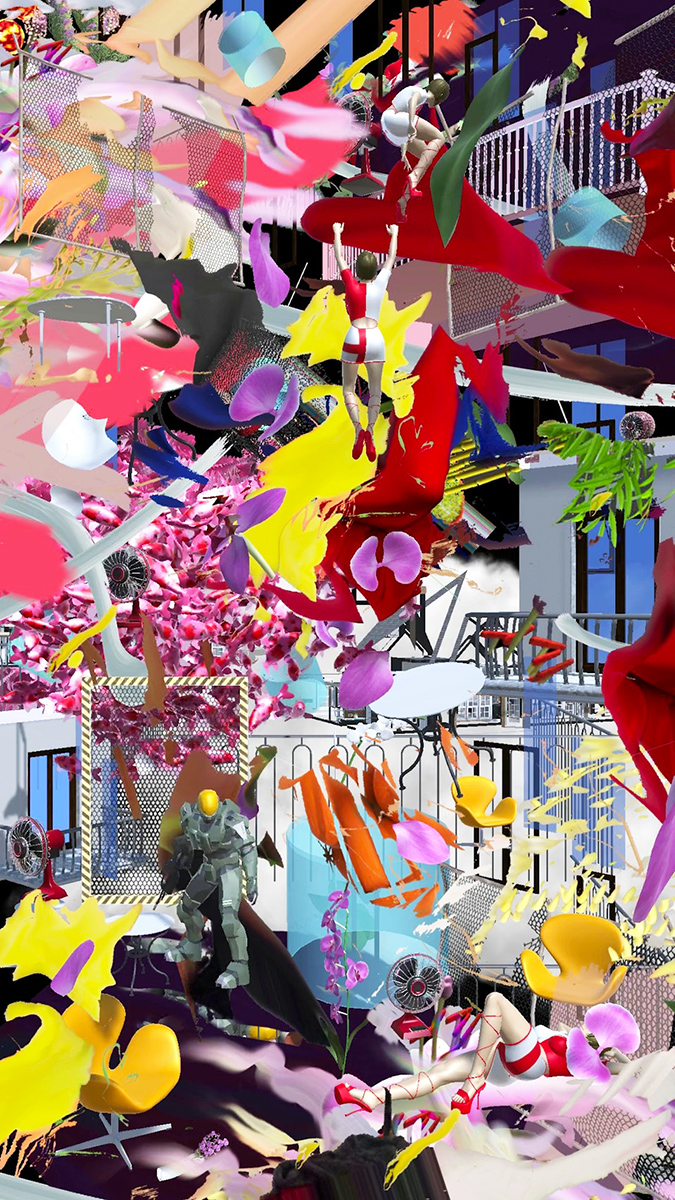
Cassie Mcquater
Halo
In these six animated paintings presented as a single channel video, the artist reenacts situations and motifs from the first-person shooter series Halo and the erotic videogame Dream Stripper. Conceived as a dynamic, virtual collage, HALO shows short stock animation loops of characters dying over and over, with koi, dining chairs, asteroids, guns, flowers, torches, pinball machines, candles, and discarded pillows floating around them, creating a hypnotic motion.

Sabrina Ratté
Aliquis (extrait)
Aliquid est une vidéo à canal unique où le signal électronique est manipulé numériquement pour se matérialiser en chair synthétique. Atterrissant lentement sur une architecture de verre, cette substance indéfinie est déchirée par des arêtes vives et finit par se désintégrer en particules qui se répandent dans l’atmosphère.

Soft Bodies
Micro-Utopia
In response to London’s pressing housing crisis Micro-Utopia proposes a shared, immersive and interactive version of a home, where space is born from the finely-tuned sensorial interplay between the body and virtual/physical objects connected to the Internet of Things. A chair invites us to stay with it for a moment; we crawl through a demanding fireplace; our hands are washed in a bowl of digital liquid – the highly speculative model of domesticity explores the architectural implication of co-inhabiting a minimal physical infrastructure within infinitely bespoke virtual worlds. Drawing on radical art practice, interiors in historical painting and contemporary product design, Micro-Utopia is the dream of a house that is nothing, but the parameters of our perception are triggered through the metaphorical dimension of the objects we interact with on a daily basis.

Manuel Jiménez Garcia and Gilles Retsin Nagami Design and Vicente Soler
Voxel Chair
Progettata da Manuel Jimenez Garcia e Gilles Retsin dello studio londinese di architettura madMdesign, VoxelChair V1.0 è una sedia/poltrona stampata in 3D che riprende le forme delle celebri sedie Phantom di Verner Panton. Nel video che pubblichiamo oggi è possibile osservare le fasi di produzione della VoxelChair, che, a differenza delle tradizionali sedute in materiali polimerici, non necessita di un costoso stampo, essendo stampata, linea per linea, da un braccio robotico. Per realizzare il prototipo della sedia è stato usato un software programmato ad hoc.

YOICHI YAMAMOTO
Japanese firm yoichi yamamoto architects has completed ‘2D/3D chairs’ for tokyo fashion labels issey miyake store. featuring a series of traditional dining chairs, the installation transforms from a two dimensional graphic into a tangible piece. The perspective is manipulated creating a unique appearance from different vantage points for onlookers. graphics of legs in varying perspectives are printed onto a horizontal plane while the chair backs rest upon the surface. The seat backs maintain a seamless transition from the graphics by utilizing assorted sizes, heights and placed at diverse angles.

MANUEL JIMÉNEZ GARCIA AND GILLES RETSIN NAGAMI DESIGN AND VICENTE SOLER
воксельное кресло
Прогресс Мануэля Хименеса Гарсии и Жиля Рецина из лондонской архитектурной студии MadMdesign, VoxelChair V1.0 – это седия / полтона в 3D, созданная для создания знаменитого фантома Фантома Вернера Пантона. В видео, которое мы публикуем сегодня, можно наблюдать этапы производства кресла VoxelChair, которое, в отличие от различных традиционных сидений из полимерных материалов, не требует дорогостоящей пресс-формы, которая печатается построчно с помощью манипулятора. Для реализации прототипа седия используется специальное программное обеспечение.

German Ermics
Ombré Glass Chair
“German Ermics is a Latvian designer who has recently presented to the public his splendid Ombré Glass Chair, which embodies the perfect tribute to To Shiro Kuramata and his iconic Glass Chair (1976), considered one of the iconic furniture designers of the 20th century. The keyword of his creation is “simplicity” combined with the transparency and the apparent lightness of the material, the result is an elegant minimal work.Another peculiarity of the chair is that it was manufactured with a new industrial product, the Photobond 100, welded without the use of screws or mounting-reinforcements, thus eliminating any superficiality.” Claudia Fuggetti

SNARKITECTURE
The Beach
The Beach is an interactive installation that reimagines the familiar natural and cultural elements of a day at the beach, to create an unexpected and memorable experience for people of all ages. Visitors ascend a ramp before entering an all-white enclosure, where the floor descends towards the highlight of the experience – an ocean of over one million recyclable, antimicrobial plastic balls. A pier extends out into the ‘sea’, allowing people to stand in the center of the space and watch others, while an island invites exploration and discovery. Visual cues such as deck chairs, lifeguard chairs, umbrellas, and signage recall elements of the typical beach-going experience.
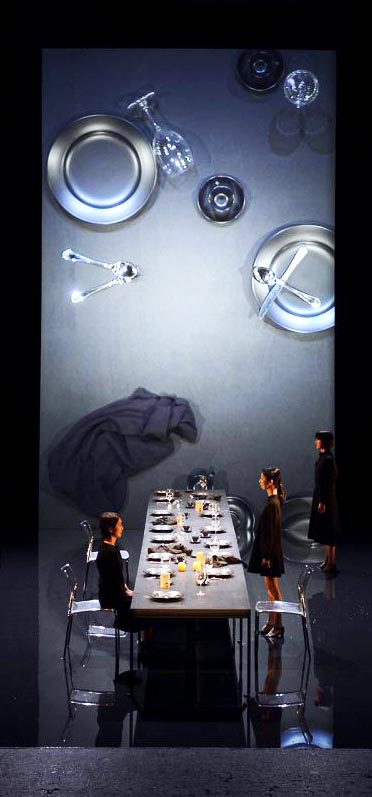
Shiro Takatani
ST/LL
ST/LL opens on a stage with a long set table, perpendicularly to the orchestra, under the eyes of the audience; on the sides of the table there are some chairs. On the background, coinciding with the inner extremity of the table, there is a projection screen developing vertically, like a painting that evokes the Japanese pictorial tradition. The perimeter of the stage is covered with a veil of water, in which everything reverberates. The whole visual structure of the work develops all around this diaphanous dimension. A man enters the scene and carries out actions on the table: he moves the cutlery, changes the position of the chairs, makes tiny gestures, which let the audience foretell that an action played on the visible will develop. To the sound of a metronome, two women and then a third one enter the scene and sit at the table making gestures that imitate a meal without food.

Dorian Gaudin
The coffee cup spring
The monotone repetition of the movement created by the conveyor belt recalls the pace and the landscape of animation or video games. As an extension of the conveyor, several geometric and orthogonal motifs evoking a Tetris composition are slotted together and suggest the shapes of a table, a chair or stairs. The objects are exposed on thin metal structures with fringed ends, and seem to peel off from their construction, as if they were undressing and exchanging skins, depriving themselves of sculptural depth and allowing only the surface to emerge. The technique developed by the artist to produce the sculptures inverts the usual steps of printing: first the pattern is created, then the background to which the fiberglass support is apposed. The pieces are therefore ripped off their mold, revealing their final texture, and the motif on every sculpture seems to remain the same, yet is altered by the shape of the object itself. A series of wall works using this procedure extends from the installation into the gallery space.

Zaha Hadid Architects
bow chair
designed by Zaha Hadid Architects, Ross Lovegrove and Daniel Widrig
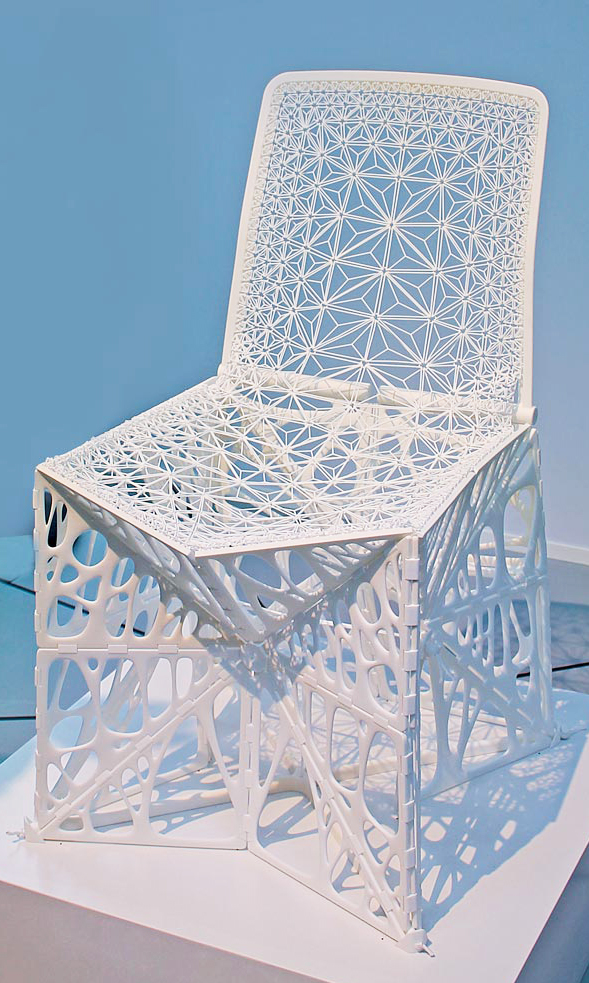
Patrick Jouin
The TAMU Chair
The result of the dialogue between designer and machine, Tamu is a foldable chair which takes up less space and the least amount of material possible to make.

Pedro Lopes, Robert Kovacs, Alexandra Ion, David Lindlbauer and Patrick Baudisch
Ad Infinitum
Ad infinitum is a parasitical entity which lives off human energy. It lives untethered and off the grid. This parasite reverses the dominant role that mankind has with respect to technologies: the parasite shifts humans from “users” to “used”. Ad infinitum co-exists in our world by parasitically attaching electrodes onto the human visitors and harvesting their kinetic energy by electrically persuading them to move their muscles. The only way a visitor can be freed is by seducing another visitor to sit on the opposite chair and take their place. Being trapped in the parasite’s cuffs means getting our muscles electrically stimulated in order to perform a cranking motion as to feed it our kinetic energy. This reminds us that, in the cusp of artificially thinking machines, we are no longer just “users”; the shock we feel in our muscles, the involuntary gesture, acknowledges our intricate relationship to uncanny technological realm around us.

Jeremy Shaw
towards universal recognition
“Shaw presents Towards Universal Pattern Recognition, a series of archival photographs framed under custom-machined prismatic acrylic. The works, which he calls optical sculptures, depict people in transcendent states accessed through prayer, dance, yoga and the like. They act as a preview to the videos, which are projected in meticulously constructed spaces, each with eight office chairs facing a single screen.” Diana Hiebert
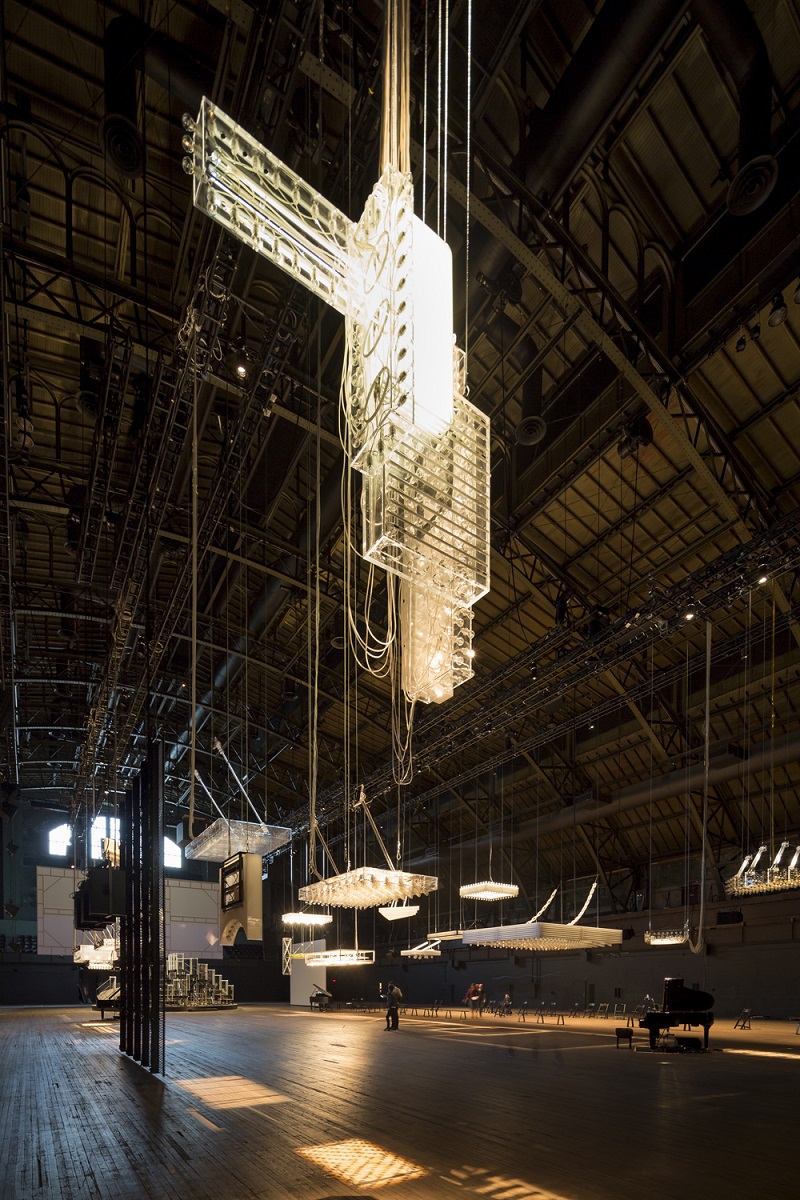
Philippe Parreno
ФИЛИПП ПАРРЕНО
فيليب بارينو
菲利普·帕雷诺
H {N)Y P N(Y} OSIS
H {N)Y P N(Y} OSIS includes a vast collection of sculptural lighting that suspends from the cavernous ceiling. glowing white shapes informed by the design of movie marquees hang above visitors in bundles and as single geometries, casting dynamic patterns on the ground. as a participant walks through the site, they meet video installations, projections, pianos, chairs, speakers and sounds, all which have been carefully orchestrated to produce an immersive, sensory, and constantly-unfolding creative environment.

SAM BUXTON
Electric Chair
The distinctive work of Sam Buxton is dominated by his innovative use of advanced materials and technologies. From his immensely popular MIKRO series (miniature fold-up sculptures, laser cut into thin strips of stainless steel through an acid etching process) to his explorations concerning interactive intelligent surfaces on the familiar objects around us, his work has continually managed to blur the lines between art, science and design.Through his work, which has regularly involved relatively common objects ranging from business cards to a dining table, Buxton has demonstrated an ability to see potential in what others take for granted. His on-going efforts in developing objects that can communicate, display information and react to the actions of the user, demonstrate his commitment to investigating the delicate relationship between the human body and its environment. Buxton’s fusion of art and science has resulted in a highly innovative and unique range of personal designs, many of which, have utilized the latest, most advanced materials and technologies available.

Daniel Widrig and Guan Lee
Ecoire Chair
Daniel Widrig and Guan Lee at University College’s London Material Architecture Lab was made from coconut fibre and starch. Its twisting, symmetrical form gives the impression of coconuts being ensconced inside.

robert gober
Untitled Door and Door Frame
Robert Gober’s work focuses around the themes of sexuality, relationships, religion, politics and nature. Working mostly in sculpture, surprisingly Gober doesn’t use found objects as a part of his work, but recreates these found objects himself and handcrafts them in his studios. Objects such as sinks, doors, cribs, chairs and body parts feature heavily in his work but yet all meticulously handmade. All the objects and installations in which Gober creates have a certain humorous element to them be it the half body that sticks out from the wall or the sink that has legs coming out of it.

Max Enrich
Stabile
Playing with the narrow line between design and pure aesthetics, I focus on a constant search for bold and suggesting forms which can be used as a chair, as a table or as a sculpture.

Zaha Hadid Architects
Rise chair
The two 3D-printed chair, designed by Zaha Hadid Architects principal Patrik Schumacher, will be displayed alongside creations by Welsh industrial designer Ross Lovegrove and London-based designer Daniel Widrig.
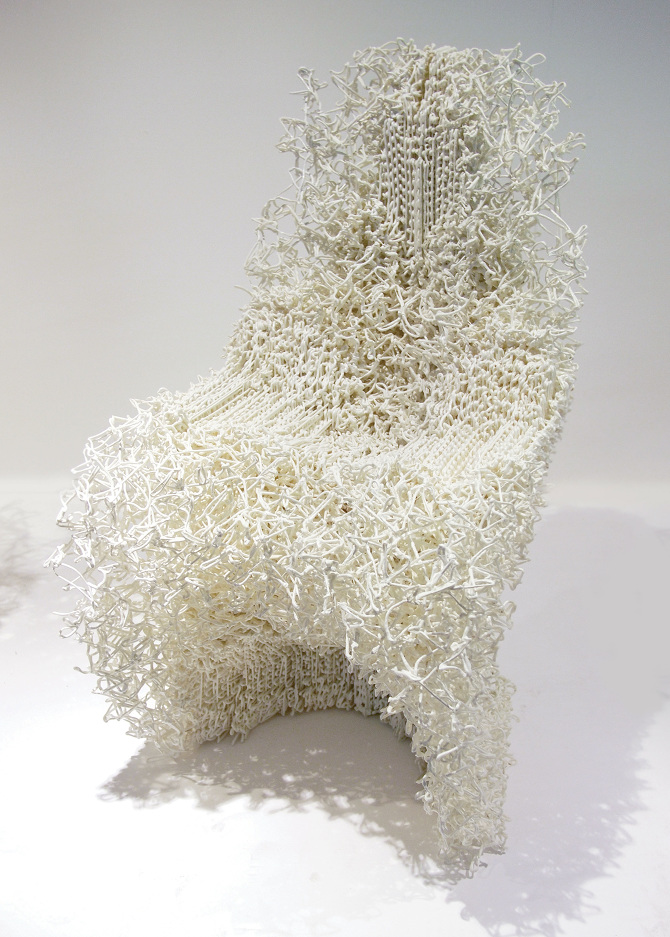
Bartlett students
build 3D-printed filigree chair
RC4-CurVoxels
Students: Claudia Tanskanen, Zoe Hwee Tan, Xiaolin Yin and Qianyi Li (INT) Panagiota Spyropoulou, Hyein Lee, Pooja Gosavi, Pratiksha Renake ( Mickey Matter) Hyunchul Kwon, Amreen Kaleel and Xiaolin Li ( CurVoxels), Efstratios Georgiou, Palak Jhunjhunwala, Juan Olaya, Yiheng Ye ( VoxaTile)

Fred Sandback
Untitled
Sandback did not try to ground his art in history or theory alone, but followed a very personal approach. Growing up, he had an uncanny fascination with things that were strung. According to his own accounts he liked to watch his uncle Fred, an antiques dealer, cane chairs, and he remembered being captivated as a child by a museum exhibition on how to make snowshoes. As a camp counselor in New Hampshire, he loved archery and began making his own bows. He also seems to have been interested in straight lines; as a freshman in college, he carved a tall, narrow cat out of wood, prefiguring a lifelong interest in linear forms.
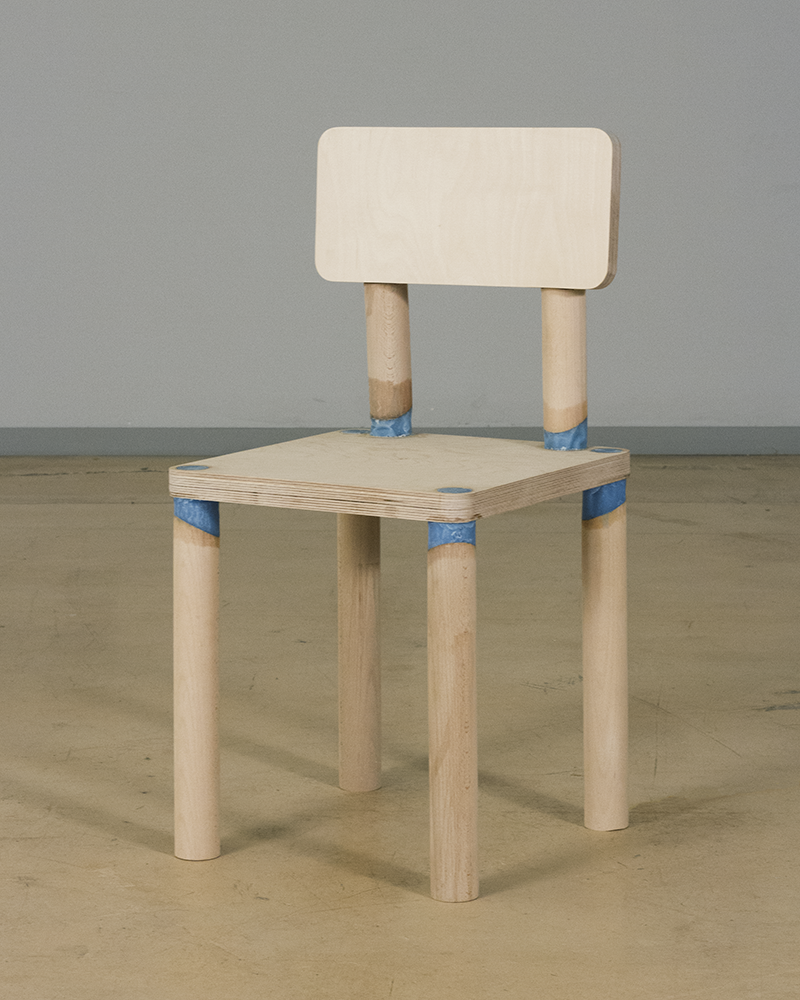
Thibault Brevet
DRM Chair (Chair that self-destructs after 8 uses)
The DRM Chair has only a limited number of use before it self-destructs. The number of use was set to 8, so everyone could sit down and enjoy a single time the chair.
A small sensor detects when someone sits and decrements a counter. Every time someone sits up, the chair knocks a number of time to signal how many uses are left. When reaching zero, the self-destruct system is turned on and the structural joints of the chair are melted.

Joyce Lin
Exploded Chair
This piece takes traditional conception of what a chair is, dismantles it, and places it in clear perspex containers. The maple-wood chair that sits loosely within its crystalline sarcophagus looks much like the archetypal kitchen seat. As the ‘Exploded Chair’ is moved, its wooden pieces rattle around inside their compartments. The piece is both familiar and disorienting, playful and disconcerting — a dichotomous piece on which to seat yourself.

Daniel Steegmann Mangrané
Ne voulais prendre ni forme, ni chair, ni matière
Daniel Steegmann Mangrané intends to totally and profoundly transform the space of the IAC. And so, the path of the exhibition, Ne voulais prendre ni forme, ni chair, ni matière, generates new vanishing lines. Defined by a sensitive geometry, driven only by rays of natural light that penetrate the gloom, it encourages exploration and groping and fumbling.
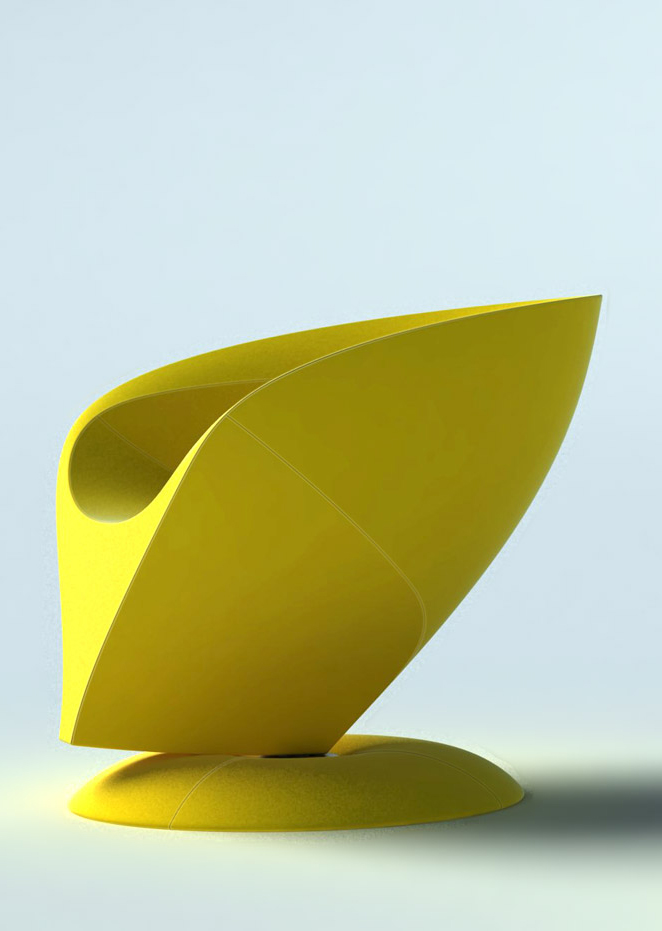
studio vertijet
Yuca easy chair
It looks like a spatial sculpture, at once experimental and inviting, rotatable and completely covered. The YUCA easy chair is reminiscent of a softly rounded cup of petals, appearing to grow out of thin air. It stands on a metal X-shaped base which is chrome-plated or lacquered. The result is a perfect shape brimming with flexibility and seating comfort.

Aranda\Lasch
阿兰达\拉希
アランダ\ラッシュ
Railing Lounge Chair
Railing is an exploration of structural modular loops that are upholstered like handle-grips to become furniture. Each piece of furniture is a single loop made up of many circles. Here, the circle does not display the qualities it is most known for, but it is what a circle can be. It is not whole or complete but is instead growing into itself. It is a circle that refuses its own dimension and finitude, that struggles to be endless.

Pawel Grunert
Chair 5
Born in Warsaw in 1965, Paweł Grunert is a designer, creator of artistic furniture and sculptor. The objects he creates fall somewhere between sculpture and applied art. He uses natural materials such as branches, straw, earth, grass, hay, reeds and wood, but he also employs bricks, fabrics and metals. He has designed and created around two hundred sculptures, spatial arrangements and pieces of furniture.

KADO BUNPEI
Tree of Chair
Through his sculptural practice, artist Pontus Willfors says that he seeks to examine “aspects of nature that are viewed by our society as product, nuisance or waste.” One of his frequently recurring motifs is the form of tree branches and root systems that sprout from from everyday objects as seen in this collection of furniture pieces that remind us explicitly of the material’s origins.
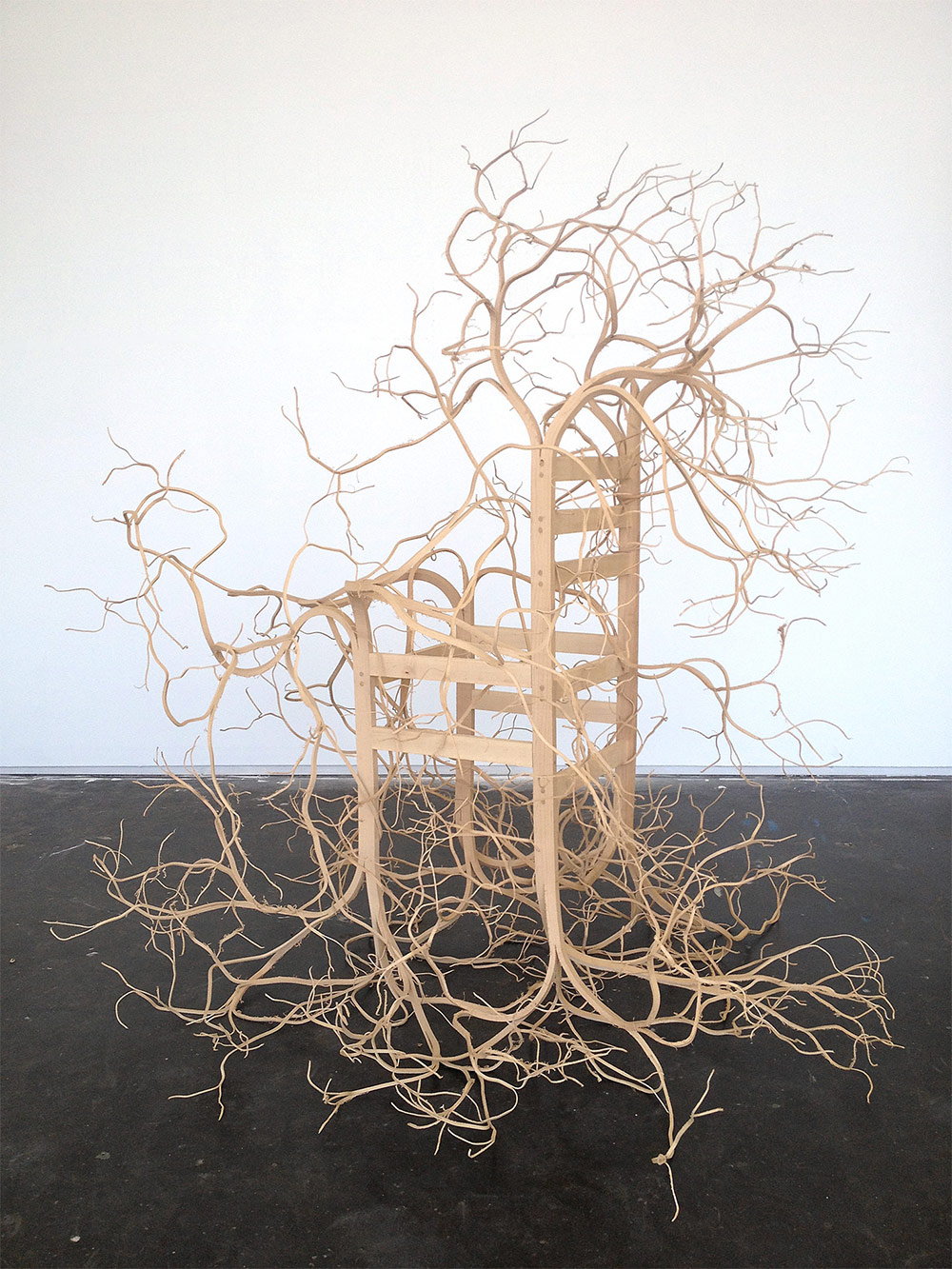
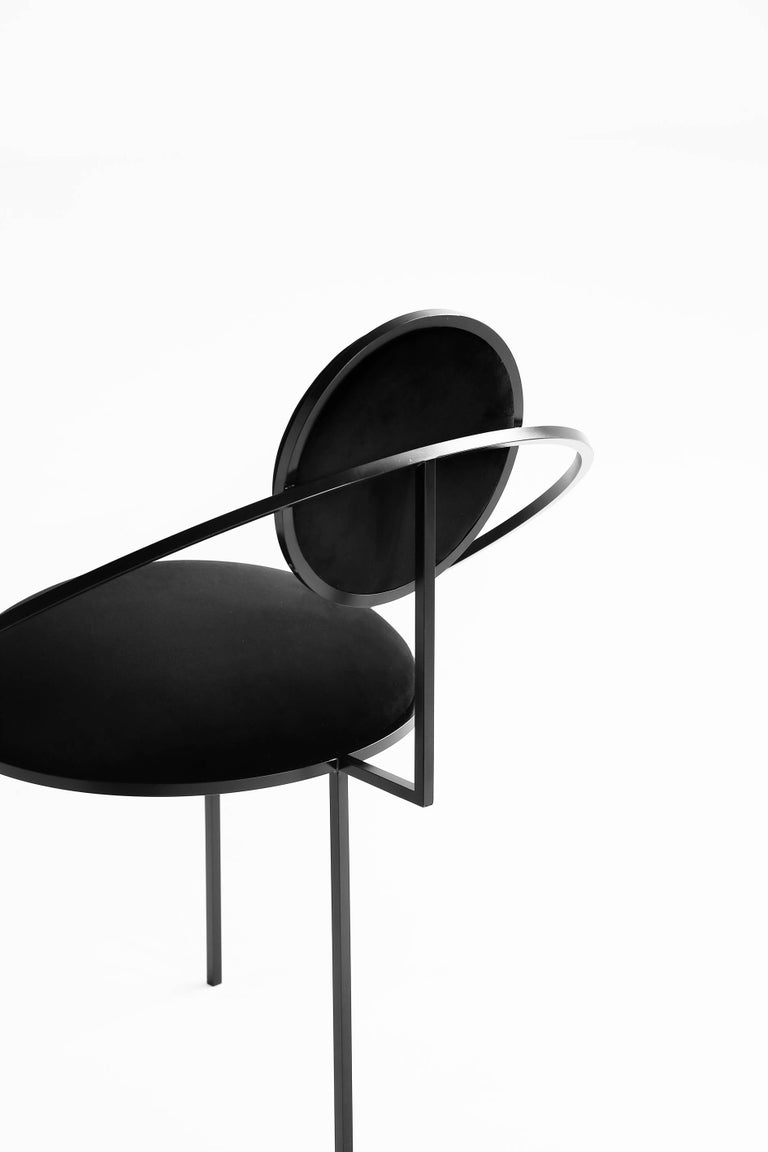
Lara Bohinc
Orbit Chair in Black
In the collection, Lara Bohinc develops her stellar themes, finding inspiration in planetary and lunar orbits, whose gravitationally curved trajectories drive the lines and shapes of the chairs. Constructed from thin square rod, the chairs are elegant, minimal and delicate. They are finished in galvanised steel and wool fabrics by Kvadrat.
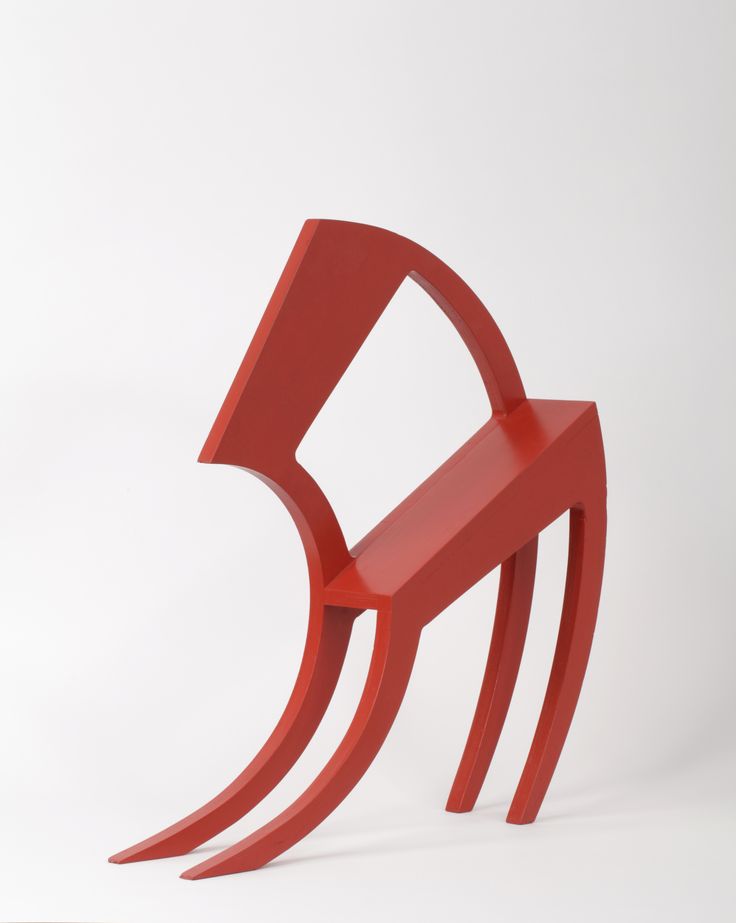
Stefan Wewerka
Class room chair
Polyfunctionality and deconstruction of everyday objects, irony and humour as weapons and moments of profound insight: these are some of the ideas behind the works by the architect, designer, sculptor and film-maker, Stefan Wewerka (born in 1928, in Magdeburg).
In his works, Wewerka pushes against conventional concepts relating to art and aesthetics, rationalism and functionalism. As a result for instance, the Last Supper is turned into a weird affair, the kitchen space turned into a kitchen tree. Wewerka’s unmistakable trademark is the manipulation of chairs. Sawn, hacked and bent out of shape, these chairs subversively thwart previously unquestioned concepts relating to furniture. In stark contrast to this, however, are his sculptural furniture designs, adapted to suit the requirements of the human body and its habits.
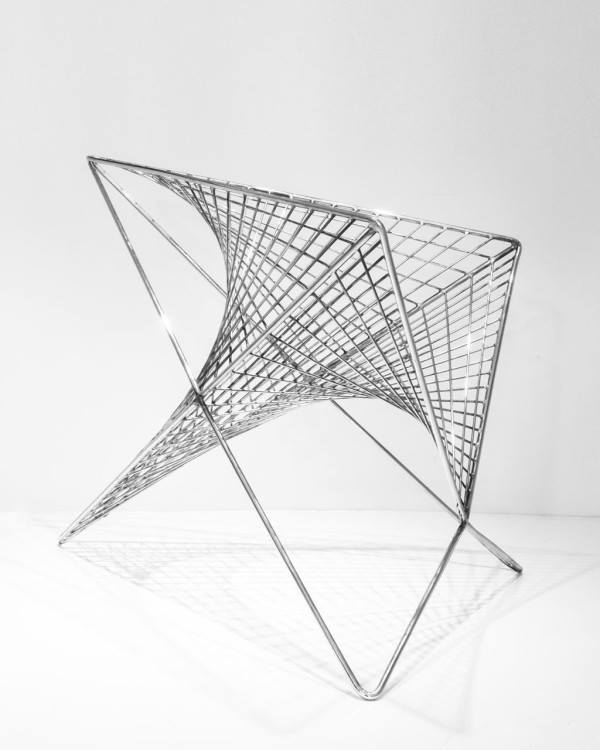
CARLO AIELLO DESIGN STUDIO
Карло Айелло дизайн-студии
卡罗艾洛设计工作室
The Parabola Chair
Kресло Parabola, спроектированное бюро Сarlo Aiello Design Studio, простое и сложное одновременно. В основе его дизайна лежит криволинейная поверхность, которая называется гиперболическим параболоидом. Однако конструкция модели несложная. Сиденья, подлокотники и спинка – это единая непрерывная структура из хромированной стали, а не части целого. Wирина кресла Parabola 71см, длина 97см, а высота 93 см. В 2013 году модель получила престижную награду International Contemporary Furniture Fair (ICFF) Studio Award.

Ronen Kadushin
Hack Chair Prototype
Ronen Kadushin (b. 1964) is an Israeli designer and design educator living in Berlin since 2005. He taught furniture design and design creativity courses at leading Israeli and European design academies since 1993. In 2004 Kadushin developed the Open Design concept, where the designs of his products can be downloaded, copied, modified and produced, much as in Open Source software.

Aranda/Lasch
1774
In the year 1774 Louis XV died, marking the sunset of one of history’s most lavish monarchies. In the same year a young Swede named Johann Gahn, working in the deepest and wettest levels of a mine, discovered the metal Manganese. At a molecular level, when combined with oxides, manganese displays a striking “super-crystal” modularity. In this solid aluminum chair, two historic events—the super-excess of Louis XV and the super-crystal of Manganese—are fused into a single moment of design
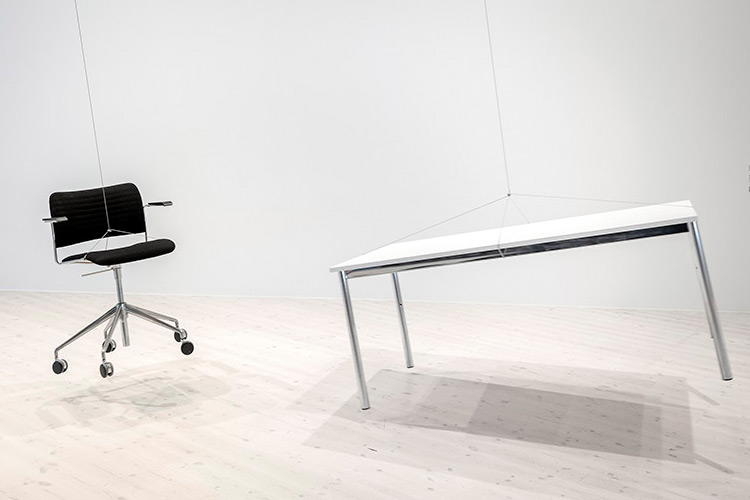
julius von bismarck
Freedom Table & Democracy Chair
Suspended from the ceiling of the exhibition space, a blue office chair and a simple table each swing in a circular orbit. At times the movement of table and chair is closely aligned, at other times out of sync. Moving in a rhythm of dance-like accompaniment, the two objects seem to have attained weightless freedom.
The table and chair originate from the gallery. Computer-operated motors determine their precise circular paths, which have marginally deferred frequencies.

Gaetano Pesce
UP-5 Chair
Geatano Pesce, au crépuscule de sa carrière, peut affirmer qu’il a bousculé l’histoire du design et plus particulièrement la façon de le concevoir. Il a affirmé très tôt l’idée selon laquelle le design doit dépasser la notion d’utilité pour devenir un objet de questionnement. Ainsi, en 1969, le designer conçoit son œuvre peut-être la plus emblématique, le Fauteuil UP5 Donna ou Chair Up Dressed. Ce fauteuil, aux formes évocatrices est une ode à la féminité… emprisonnée et sous le joug de la domination masculine. Une assise très confortable et profonde pour se lover dedans, complétée par un pouf lui-même retenu au fauteuil par une chaîne. Selon le maître italien : « Cette réalisation m’a permis d’exprimer ma vision de la femme. Toujours sédentaire, elle reste malgré elle prisonnière d’elle-même. La forme de ce fauteuil, évoquant les formes généreuses d’une femme, retenue par un boulet au pied, m’a permis de renvoyer à l’image traditionnelle du prisonnier ».

Patrick Jouin
solid chair
Der Solid C2 Stuhl von Patrick Jouin ist ein Highlight in der wachsenden Gruppe digital gestalteter und produzierter Werke des Museums. Wir sind unseren Mitgliedern zutiefst dankbar, dass sie diese Akquisition ermöglicht haben. Der Stuhl wurde nach einem Verfahren namens Stereolithographie hergestellt, einer Art 3D-Druck, bei dem ein computergesteuerter Laser ein lichtempfindliches Epoxidharz bei Kontakt erwärmt und verfestigt. Dieser Prozess erstellt eine Form, Schicht für Schicht, um ein einzelnes vollständiges Objekt zu erstellen. Dieses Verfahren unterscheidet sich stark von herkömmlichen handwerklichen oder herkömmlichen Massenproduktionsverfahren wie Zusammenbau, Schnitzen und Formen.


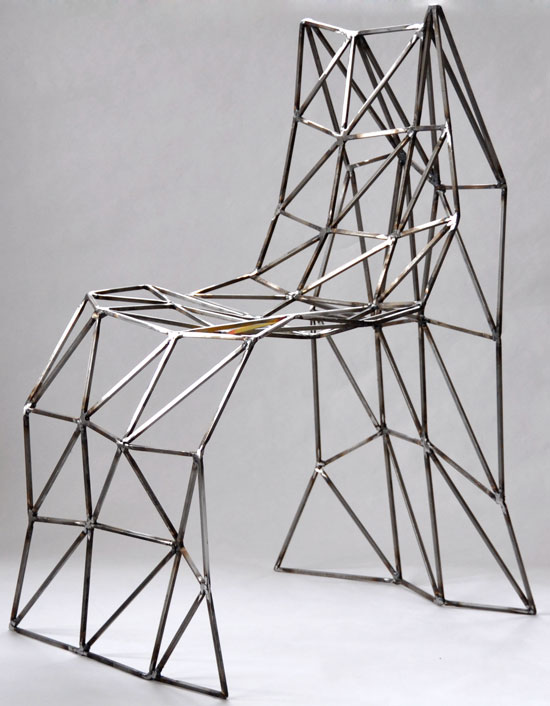
JULIAN MAYOR
Graziano Chair
The Graziano chair was inspired by computer generated wire-frame models, and by toughness coupled with fragility. Wire frame drawings express form though an economical use of marks, and with their own set of codes, they allow a viewer to look at the inside and outside of an object at the same time, and from many angles simultaneously.

SERGEI TCHEREPNIN
Ear Tone Box
“I am interested in transforming various mundane objects into speakers. Listening to sound through a cardboard box is very different from listening through a chair, which is very different from listening through computer speakers. In these works, I am attempting to expand aural dimensions by orchestrating flexible listening situations, which draw attention to the materiality and variation of sound as filtered through these objects.”

Plummer Fernandez
Sound Chair
British/ Colombian Artist and Designer Matthew Plummer-Fernandez makes work that critically examines sociocultural entanglements with technologies. His current interests span algorithms, bots, automation, copyright, 3D files and file-sharing. He publishes his research on the peer-favoured algopop blog.

JUN HASHIMOTO
Web Chair
Web Chair è un omaggio al web e alla sua inestricabile rete, leggera e nel contempo salda e forte. La sedia è un progetto della designer Jun Hushimoto di Junio Design, è pensata interamente in acciaio inossidabile e contiene più di 2000 punti di saldatura. E’ stata presentata tempo fa al SaloneSatellite di Milano, ma è ancora così attuale e bella nella sua semplicità! Il suo punto di forza è proprio l’estrema leggerezza, la sua caratteristica la rende adatta ad un arredo moderno, ad un spazio ufficio o al contract ed è assolutamente perfetta per chi ama cambiare posizione agli oggetti all’interno della casa.

